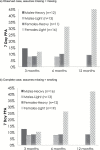Gender differences in a randomized controlled trial treating tobacco use among adolescents and young adults with mental health concerns
- PMID: 25762759
- PMCID: PMC4402352
- DOI: 10.1093/ntr/ntu205
Gender differences in a randomized controlled trial treating tobacco use among adolescents and young adults with mental health concerns
Abstract
Introduction: Treatment of tobacco use in mental health settings is rare despite high rates of comorbidity. With a focus on early intervention, we evaluated a tobacco treatment intervention among adolescents and young adults recruited from outpatient, school-based, and residential mental health settings and tested for gender differences.
Methods: Intervention participants received computerized motivational feedback at baseline, 3 months, and 6 months and were offered 12 weeks of cessation counseling and nicotine patches. Usual care participants received a self-help guide and brief cessation advice. We examined 7-day point prevalence abstinence with biochemical confirmation at 3, 6, and 12 months; smoking reduction; and 24-hr quit attempts.
Results: At baseline, the sample (N = 60, 52% female, mean age = 19.5±2.9 years, 40% non-Hispanic Caucasian) averaged 7±6 cigarettes/day, 62% smoked daily, 38% smoked ≤ 30 min of waking, 12% intended to quit in the next month, 47% had a parent who smoked, and 3 of 5 of participants' closest friends smoked on average. During the 12-month study, 47% of the sample reduced their smoking, 80% quit for 24 hr, and 11%, 13%, and 17% confirmed 7-day point prevalence abstinence at 3-, 6-, and 12-month follow-up, respectively, with no differences by treatment condition (ps > .400). Over time, abstinence was greater among girls (adjusted odds ratio [AOR] = 8.9) than among boys, and abstinence was greater for lighter smokers than heavier smokers (AOR = 4.5) (p < .05). No mental health or other measured variables predicted abstinence.
Conclusions: Adolescent and young adult smokers with mental health concerns are a challenging group to engage and to effectively treat for tobacco addiction, particularly heavier smokers and boys. Innovative approaches are needed.
© The Author 2015. Published by Oxford University Press on behalf of the Society for Research on Nicotine and Tobacco. All rights reserved. For permissions, please e-mail: journals.permissions@oup.com.
Figures
References
-
- Kann L, Kinchen S, Shanklin SL, et al. Youth risk behavior surveillance–United States, 2013. MMWR Surveill Summ. 2014;63:1–72. - PubMed
-
- US Department of Health and Human Services. (1994). Preventing tobacco use among young people: A report of the surgeon general. Atlanta, GA: USDHHS, CDC, Office on Smoking and Health.
-
- Sussman S, Lichtman K, Ritt A, Pallonen UE. Effects of thirty-four adolescent tobacco use cessation and prevention trials on regular users of tobacco products. Subst Use Misuse. 1999;34:1469–1503. - PubMed
Publication types
MeSH terms
Substances
Grants and funding
LinkOut - more resources
Full Text Sources
Other Literature Sources
Medical


